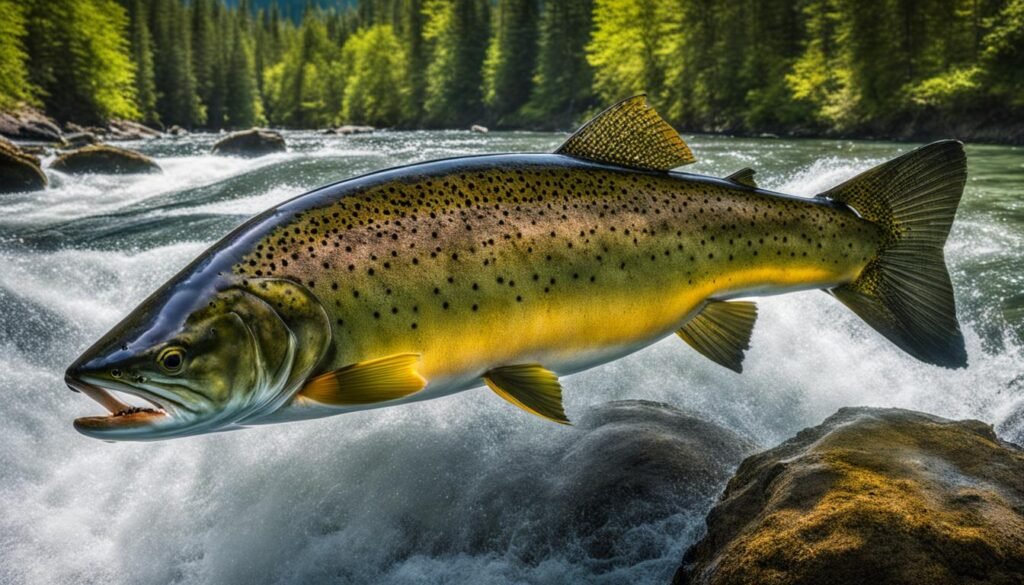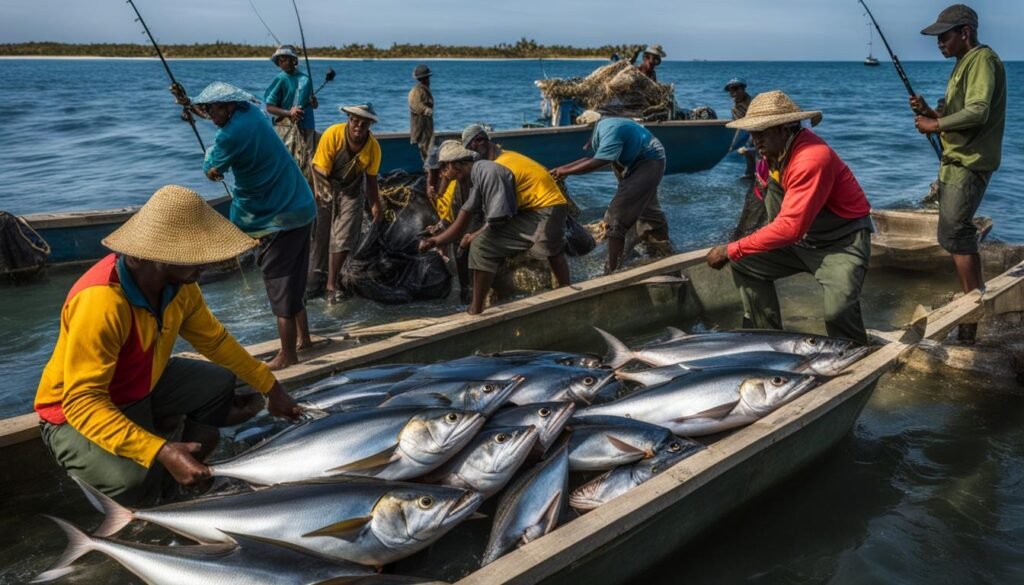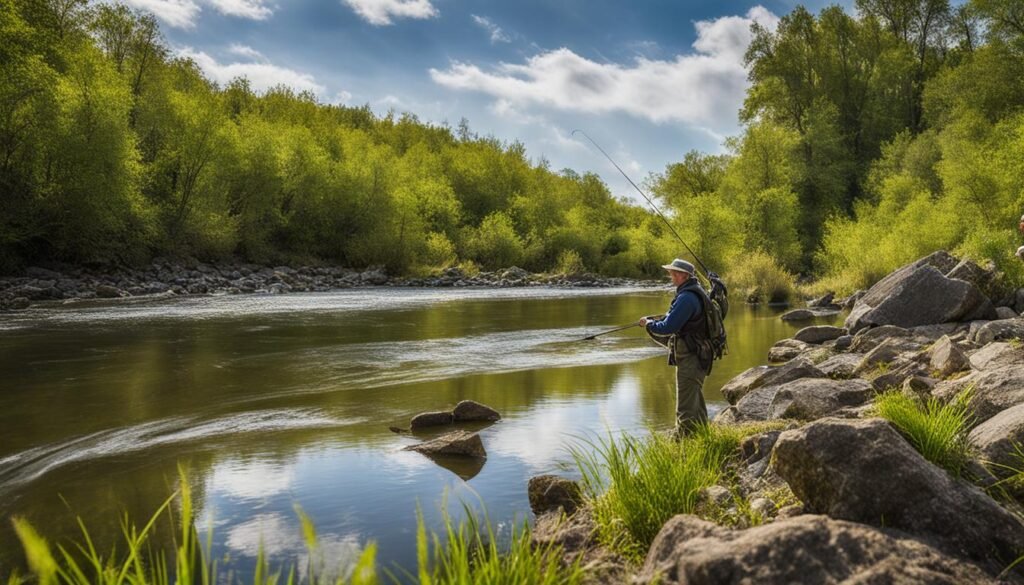By adopting sustainable angling practices and taking responsibility for habitat conservation, we can make a significant impact on the health and sustainability of aquatic ecosystems. Our efforts are essential for ensuring the future of our favorite fishing spots and the fish populations that rely on them.
Conservation Through Appreciation – Karen Talbot Art
At Karen Talbot Art, our mission is to promote the concept of “Conservation through Appreciation.” We believe that anglers play a crucial role in the conservation of fish habitats through their deep appreciation for the species they love and the habitats they recreate in.
Anglers have a unique opportunity to observe firsthand the beauty and intricacy of aquatic ecosystems. By immersing themselves in nature and experiencing the wonders of fish habitats, anglers develop a profound connection and understanding of the importance of preserving these environments.
We encourage anglers to engage in discussions about angler conservation efforts and the significant impact they have on habitat preservation. By supporting organizations and agencies dedicated to habitat protection and restoration, anglers can contribute to the long-term health and sustainability of aquatic ecosystems. Together, we can ensure that future generations can continue to enjoy the beauty and abundance of fish habitats.
The Power of Collaboration
Collaboration is key to successful angler-led conservation efforts. By working together with fellow anglers, environmental organizations, and government agencies, we can amplify our impact and achieve greater results. Sharing knowledge, experiences, and best practices enables us to implement effective strategies for habitat protection and restoration.
Education and Awareness
Education and awareness are vital in inspiring anglers to become stewards of fish habitats. By sharing information about the value of healthy ecosystems, the threats they face, and the importance of sustainable angling practices, we can empower anglers to make informed decisions and take active steps towards conservation.
- Organize workshops and seminars to educate anglers about the importance of habitat preservation.
- Collaborate with local schools and community organizations to raise awareness about the role of anglers in conservation.
- Utilize social media platforms to share stories, tips, and success stories related to angler-led habitat preservation efforts.
Preserving Brook Trout Populations
Brook trout, the beautiful and iconic native fish species of Maine, are facing significant challenges to their survival. These remarkable fish are the last remaining wild, native brook trout populations in the United States, making their preservation all the more critical. Habitat degradation, climate change, and the introduction of invasive species are threatening their fragile ecosystems.
As anglers, we have a responsibility to contribute to the conservation of brook trout populations. By adopting sustainable angling practices, avoiding the use of illegal live bait, and advocating for better habitat management, we play a crucial role in preserving these national treasures. Our actions, both individually and collectively, can make a significant impact on the future of brook trout populations. It is up to us to ensure that future generations have the opportunity to enjoy the thrill of catching a wild brook trout in its natural habitat.
The Angler’s Role in Habitat Conservation
- Adopt sustainable angling practices: By practicing catch and release, using barbless hooks, and respecting fishing regulations, we can minimize our impact on brook trout habitats.
- Support habitat restoration efforts: Get involved with local conservation organizations and participate in restoration projects that focus on improving water quality, restoring riparian vegetation, and enhancing stream habitats.
- Advocate for better habitat management: Engage in discussions with angling communities, state agencies, and policymakers to promote habitat conservation and restoration initiatives. By raising awareness about the importance of brook trout habitats, we can drive positive change.
- Stay informed: Keep up-to-date with the latest research and conservation efforts related to brook trout populations. By staying informed, we can better understand the challenges they face and take appropriate action.
Managing Non-Native Brown Trout
Brown trout, originally introduced as a non-native species in North America, have established self-sustaining wild populations, often at the expense of native fishes like brook trout. While brown trout provide recreational opportunities for anglers, their presence can have negative implications for the conservation of native species and their habitats.
One of the major concerns of brown trout introductions is the potential impact on native fishes. Brown trout are known to outcompete native species for limited resources such as food and spawning areas, leading to declines in their populations. Additionally, brown trout hybridization with native trout species can further threaten the genetic integrity of these native populations.
As responsible anglers, we have a role to play in conserving native species and their habitats. By discussing the challenges and implications of non-native brown trout on native fish populations, we can raise awareness about the need for habitat restoration and conservation efforts. Additionally, we can advocate for responsible fishing practices, such as catch and release, in areas where native species are at risk.
The impact of non-native brown trout can be mitigated through:
- Promoting education and awareness about the ecological impact of brown trout introductions on native fish populations
- Supporting conservation organizations and initiatives focused on the preservation of native species and their habitats
- Advocating for the removal of non-native brown trout populations in sensitive areas to protect native fish species
- Engaging in discussions with fisheries management agencies to develop strategies for minimizing the negative impact of non-native species on native ecosystems
Protecting Cutthroat Trout from Hybridization
When it comes to protecting the majestic cutthroat trout, anglers have a vital role to play. Native to the western United States, this species is facing numerous threats, including habitat degradation, climate change, and competition from non-native trout species. One of the key concerns for cutthroat trout conservation is the risk of hybridization with other trout species, which can lead to a loss of genetic diversity and the overall health of the population.
To safeguard the pure sub-species of cutthroat trout, anglers must prioritize the protection of headwaters. These pristine cold-water habitats serve as crucial spawning and rearing areas for the species. By advocating for the preservation of headwaters and engaging in restoration work, anglers can help ensure that cutthroat trout populations have a safe haven to thrive and reproduce.
The Risks of Hybridization
- Hybridization can result in the loss of unique genetic traits and adaptations that are essential for the survival of cutthroat trout in their specific habitats.
- Interbreeding with non-native trout species can dilute the genetic integrity of the pure sub-species, making them more vulnerable to environmental changes and reducing their ability to adapt to new conditions.
- Hybridized populations may also have reduced fitness and reproductive success, further impacting the long-term sustainability of cutthroat trout.
Conservation of Pure Sub-Species
- Protecting headwaters and maintaining the genetic purity of cutthroat trout populations is critical for their long-term survival.
- Conservation efforts should focus on preventing the introduction and establishment of non-native trout species in areas inhabited by pure sub-species of cutthroat trout.
- Restoration projects that remove barriers and improve connectivity between different habitats can help prevent hybridization and ensure the preservation of pure sub-species.
Preserving Cutthroat Trout’s Cold-Water Habitats
- Cutthroat trout rely on cold-water habitats, such as pristine mountain streams and high-elevation lakes, for spawning, rearing, and seeking refuge from warmer temperatures.
- Protecting these habitats from pollution, sedimentation, and other forms of degradation is crucial for the survival of cutthroat trout.
- Anglers can support habitat preservation efforts by advocating for responsible land management practices, participating in clean-up activities, and raising awareness about the importance of protecting cold-water environments.
Conserving Rainbow Trout Populations
Rainbow trout, a species originating from Pacific tributaries, have been widely introduced as a gamefish across the United States. While anglers appreciate the sport and beauty of rainbow trout, their introductions have often caused detrimental impacts on native fish species. These impacts include competition for resources, predation, and genetic dilution through hybridization. It is important for us to understand the threats to native fishes and the role that hatchery-reared fish play in these dynamics.
The Impact of Rainbow Trout Introductions
The introduction of rainbow trout can disrupt the delicate balance of native fish populations. They often outcompete native species such as brook trout for food and habitat, leading to a decline in native fish populations. Additionally, rainbow trout can hybridize with closely related species, resulting in genetic dilution and potential loss of distinct genetic traits unique to native populations.
The Role of Hatchery-Reared Fish
Hatchery-reared fish, including rainbow trout, are often stocked in rivers and lakes for recreational purposes. While this allows anglers to enjoy the thrill of fishing for rainbow trout, there are considerations to be made regarding the impact of these hatchery fish on native populations. Hatchery-reared fish may compete with native fish for resources, alter the genetic diversity of wild populations, and potentially spread diseases or parasites.
- Responsible fishing practices, such as catch-and-release, can minimize the impact on native fish populations.
- Removing non-native rainbow trout populations from sensitive habitats can help protect native species like brook trout.
- Public discussions and awareness about the ecological consequences of rainbow trout introductions can encourage responsible angling practices and support the conservation of native fish populations.
By advocating for responsible fishing practices, engaging in constructive conversations, and supporting measures that consider the conservation of native fish species, we can contribute to the long-term preservation of rainbow trout populations and the overall health of aquatic ecosystems.
Protecting the Keystone Species: Chinook Salmon

Chinook salmon, also known as king salmon, are vital to the Pacific Northwest’s ecosystem. These magnificent fish serve as a keystone species, playing a crucial role in maintaining the balance of aquatic biodiversity. However, Chinook salmon populations face numerous threats that require our immediate attention and action.
One of the major threats to Chinook salmon is the presence of dams in their natural habitats. Dams disrupt the natural flow of rivers and prevent salmon from reaching their spawning grounds. As a result, the salmon populations decrease, and the entire ecosystem suffers. To address this issue, ongoing dam removal projects have been initiated. These projects aim to restore the rivers and allow Chinook salmon to freely migrate, reproducing and rejuvenating their populations. By participating in discussions about the effects of dams on Chinook salmon and supporting dam removal projects, anglers actively contribute to the preservation of this important species.
Threats to Chinook Salmon:
- Habitat loss due to dams
- Overfishing
- Changing ocean conditions
Angler Discussions:
- Effects of dams on Chinook salmon populations
- Supporting dam removal projects
- Promoting sustainable fishing practices
Anglers also have a significant role to play in advocating for the conservation of Chinook salmon. By engaging in conversations about the threats facing this species, such as overfishing and changing ocean conditions, anglers raise awareness and promote responsible fishing practices. Through these discussions, anglers can contribute to the development and implementation of sustainable fishing strategies that help protect Chinook salmon populations for future generations to enjoy.
Protecting the keystone species like Chinook salmon is not only crucial for the ecological balance but also for the countless recreational and economic opportunities they provide. By actively participating in discussions, supporting dam removal projects, and advocating for sustainable fishing practices, anglers play a vital role in safeguarding the future of Chinook salmon.
Conserving Endangered Bluefin Tuna
Bluefin tuna, with its majestic size and incredible speed, is in grave danger of extinction due to overfishing in commercial fisheries. The conservation status of bluefin tuna raises significant concerns about the future of this iconic species and the need for sustainable fishing practices.
As anglers, we have a responsibility to play our part in preserving the bluefin tuna population. By advocating for sustainable fishing practices, such as catch and release, and supporting well-managed recreational and commercial quotas, we can contribute to the conservation efforts for this magnificent species. Our choices as consumers also have an impact. By making responsible consumption choices, such as opting for locally caught bluefin tuna taken on rod-and-reel, we can help ensure the survival and recovery of bluefin tuna populations.
The Role of Sustainable Fishing Practices
- Advocating for catch and release practices to minimize the impact on bluefin tuna populations
- Supporting well-managed recreational and commercial quotas to prevent overfishing
- Using selective fishing methods to avoid accidental catches of bluefin tuna
Responsible Consumption Choices
- Choosing locally caught bluefin tuna taken on rod-and-reel, which promotes sustainable fishing practices
- Being mindful of the source of bluefin tuna and avoiding species caught through unsustainable methods
- Supporting initiatives that promote responsible and sustainable seafood consumption
Ensuring the Future of Yellowfin Tuna

Conservation concerns for yellowfin tuna have raised alarm bells among anglers and conservationists alike. As an important species that plays a vital role in marine ecosystems, it is crucial to implement sustainable fishing methods to protect their populations for future generations.
One of the primary concerns is the impact of commercial purse-seine fisheries on yellowfin tuna. These fisheries often result in high bycatch rates and unintentional catches of juvenile yellowfin tuna. To address this issue, anglers can advocate for the use of selective fishing methods that minimize accidental catches. By practicing catch and release and avoiding areas with high concentrations of juvenile yellowfin, we can help ensure the sustainability of their populations.
Another aspect to consider is the management of skipjack harvest limits. Skipjack tuna often co-shoal with juvenile yellowfin tuna, making it essential to establish appropriate harvest limits to prevent overfishing and protect the future of yellowfin populations. By participating in discussions about skipjack harvest limits and supporting responsible fishing practices, we can contribute to the conservation efforts of yellowfin tuna.
Key points:
- Yellowfin tuna faces conservation concerns, requiring action to protect their populations and habitats.
- Advocate for selective fishing methods to reduce accidental catches of juvenile yellowfin tuna.
- Participate in discussions and support efforts to establish appropriate skipjack harvest limits.
- Practice catch and release and avoid areas with high concentrations of juvenile yellowfin to ensure sustainability.
Striped Bass Conservation Efforts
Striped bass populations have faced significant declines in the past, primarily due to commercial fishing and other stressors. However, thanks to conservation efforts, their populations have shown signs of recovery. Despite these positive developments, concerns about habitat health and disease remain, highlighting the ongoing need for conservation initiatives.
As anglers, we play a crucial role in the preservation of striped bass populations. By adhering to fishing regulations and practicing responsible angling, we can minimize our impact on these fish and their habitats. Additionally, we can take individual actions to protect their habitat and ensure their long-term survival.
Here are some important actions we can take:
- Limit or eliminate the use of fertilizers and manage runoff to prevent pollution in water bodies where striped bass reside.
- Support and engage in discussions about the importance of habitat health and restoration projects that directly benefit striped bass populations.
- Advocate for the establishment and enforcement of marine protected areas to safeguard critical spawning and feeding grounds.
- Participate in citizen science programs that monitor striped bass populations and provide valuable data for conservation efforts.
Preserving Atlantic Salmon and American Shad
Habitat degradation poses a significant threat to the populations of Atlantic salmon and American shad. These iconic species have faced considerable challenges due to overexploitation and the deterioration of their breeding habitats. However, ongoing restoration projects, such as dam removal and the creation of fish passages, are playing a vital role in efforts to restore and protect their habitats.
Recreational angling also plays a crucial role in the conservation of Atlantic salmon and American shad. By engaging in discussions about the importance of recreational angling and its impact on these species, anglers can contribute to raising awareness about the need to preserve their habitats. By supporting restoration efforts and spreading the word about their significance, we can help ensure the continued survival of Atlantic salmon and American shad populations.
The Importance of Habitat Preservation
- Habitat degradation threatens the breeding grounds of Atlantic salmon and American shad.
- Restoration projects, such as dam removal and fish passage creation, help restore and protect their habitats.
- Recreational angling plays a vital role in highlighting the importance of preserving their habitats.
Supporting Restoration Efforts
- Engage in discussions about recreational angling and its impact on these species.
- Spread awareness about the significance of restoring and protecting Atlantic salmon and American shad habitats.
- Support restoration projects aimed at enhancing the breeding grounds of these iconic species.
By working together to preserve the habitats of Atlantic salmon and American shad, we can ensure that future generations will continue to enjoy the beauty and abundance of these remarkable fish.
Mahi Mahi and Tarpon Conservation
As anglers, we have a crucial role to play in the conservation of mahi mahi and tarpon populations. These magnificent species face threats such as overfishing and habitat degradation, which require our collective efforts to address. By adopting sustainable fishing practices, we can help ensure the long-term survival of mahi mahi and tarpon while maintaining the health of their habitats.
Responsible angling is key to the conservation of these species. It involves practicing catch and release, avoiding unnecessary harm to fish, and adhering to size and bag limits. These practices allow us to enjoy the thrill of the catch while minimizing our impact on mahi mahi and tarpon populations.
Protection of habitats is another critical aspect of our conservation efforts. Mahi mahi and tarpon rely on healthy ocean ecosystems for their survival. By advocating for measures that safeguard these habitats, such as supporting marine protected areas and avoiding areas prone to habitat destruction, we can contribute to the preservation of these species.
Together, through our commitment to sustainable fishing practices and the protection of habitats, we can make a difference in the conservation of mahi mahi and tarpon. Let’s continue to promote responsible angling and raise awareness about the importance of preserving these remarkable species for future generations.

